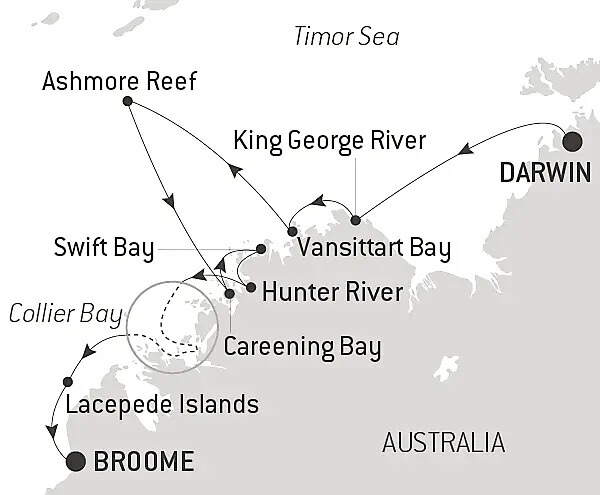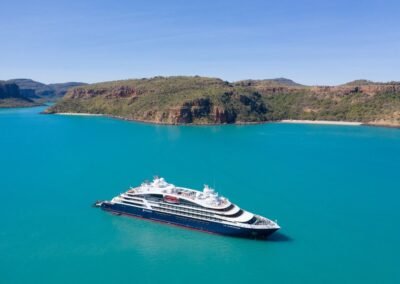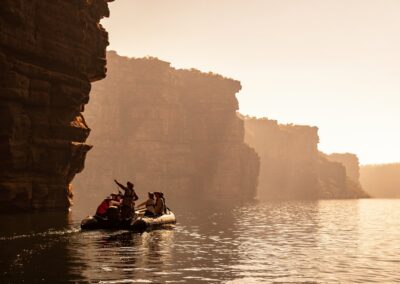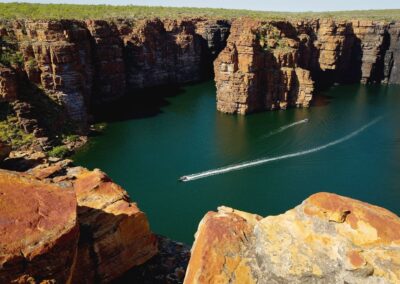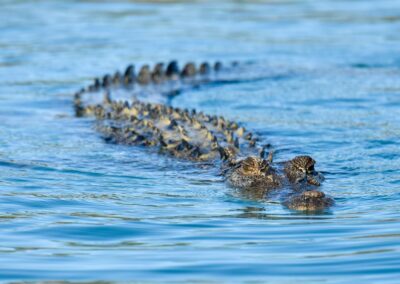Cruise Australia’s Kimberley in 2026
From $15,709pp
Step aboard for the adventure of a lifetime as you explore one of the most untouched corners of the world — Australia’s breathtaking Kimberley. Think towering red cliffs, cascading waterfalls, ancient rock art, and remote coastlines teeming with wildlife — from crocodiles and wallabies to turtles and rare sea birds.
With Ponant’s 2026 Fly, Stay & Cruise package, you’ll discover it all in effortless luxury. Relax in your private suite, enjoy open-bar dining, and experience expertly guided excursions by Zodiac — all from the comfort of one of Ponant’s elegant small ships.
Package Inclusions:
![]() Return economy flights from Auckland, Wellington or Christchurch.
Return economy flights from Auckland, Wellington or Christchurch.![]() 1-night accomodation pre or post cruise. with transfers
1-night accomodation pre or post cruise. with transfers![]() Transfers to/from hotel
Transfers to/from hotel![]() 10-night Kimberley luxury small ship expedition with Ponant
10-night Kimberley luxury small ship expedition with Ponant![]() All meals, open bar, unlimited Wi-Fi, excursions and more.
All meals, open bar, unlimited Wi-Fi, excursions and more.
Cruise Itinerary:
(Darwin to Broome, Or reverse)
DAY 1: Darwin
Darwin, the capital of Australia’s Northern Territory—known as the “Top End”—is a vibrant tropical city with a relaxed, multicultural vibe. Home to over 50 cultures, it’s proud of its laid-back lifestyle and rich recent history. Explore highlights like the tropical-style Parliament House, opened in 1994, and Admiralty House, a heritage-listed building that has withstood cyclones and wartime air raids.
Embark the cruise between 4:00–5:00pm.
Departure is at 6:00pm.
DAY 2: King George River
The journey up the King George River is truly breathtaking. The towering 80-metre-high walls of ancient Warton sandstone shift in colour and texture with the changing light, creating a stunning and ever-evolving landscape.
At the river’s end lie the King George twin falls—the tallest single-drop waterfalls in the Kimberley (80m). Fed by wet season run-off, their flow varies each year. Your Expedition Team will take you by zodiac or tender to the base of the falls, sharing insights into the remarkable geology of the canyon.
Day 3: Vansittart Bay
Jar Island is home to ancient Gwion Gwion rock art, unique to the Kimberley. Once overlooked in favour of the more dramatic Wandjina style, Gwion Gwion art has gained global recognition and is believed to date back over 30,000 years—making it the oldest detailed human depictions in the world.
Join your Expedition Team for a short walk past striking rock formations to view these remarkable galleries.
Day 4: Ashmore Reef
Located 600km North of Broome, on the edge of the continental shelf, Ashmore reef consists of 3 low-lying tropical islands surrounded by coral reef. The islands have a combined land area of approximately 54 hectares and are a designated important bird area (IBA).
Visitation to Ashmore reef and Islands is strictly controlled and most of the reef is designated as a sanctuary zone where access is prohibited. Our visit to Ashmore reef is required to ensure we comply with Australian government regulations.
Should weather, sea and tide conditions permit there may be an opportunity for guests to undertake a zodiac tour to the vicinity of West Island.
Day 5: Careening Bay
Careening Bay was named by Lieutenant Phillip Parker King, who careened his leaking ship, HMC Mermaid, here in 1820 during his third voyage of discovery. For ten days, the crew worked to repair the vessel before refloating it. The ship’s carpenter carved the name and year into a prominent boab tree, which still stands today—now 3 metres wide and National Heritage listed—a lasting reminder of Australia’s early exploration.
Day 6: Swift Bay
The Bonaparte Archipelago is a spectacular maze of rugged islands stretching nearly 150 km along the remote Kimberley coast. Its vast scale and striking colours are truly breathtaking. Largely untouched due to its isolation, it remains a pristine place to explore.
Swift’s Bay, named by Phillip Parker King after Gulliver’s Travels author Jonathan Swift, features fractured sandstone and numerous rock shelters. These shelters contain both Wandjina and Gwion Gwion rock art—join your Expedition Team ashore for a guided walk to view these remarkable galleries.
Day 7: Hunter River
Prince Frederick Harbour and the Hunter River are among the most scenic parts of the Kimberley coast, with ancient rainforest pockets, pristine mangroves, and striking sandstone cliffs. Home to up to 18 mangrove species, this rich ecosystem supports diverse wildlife, including many bird species and the iconic saltwater crocodile.
Explore the area by zodiac with your expert Expedition Team, who will help spot wildlife along the way. You’ll also have the option to take a helicopter flight to the spectacular Mitchell Falls from Naturalist Island beach.
Days 8 + 9: Collier Bay
East of the Buccaneer Archipelago, Collier Bay’s ancient landscapes have been sculpted by some of the world’s largest tides—over 14 metres near Yule Entrance—creating a true photographer’s paradise. This powerful tidal movement gives rise to extraordinary natural phenomena found nowhere else.
At its heart lies Montgomery Reef, the world’s largest inshore reef, where falling tides reveal cascading torrents and mini waterfalls. At the bay’s southern end is Talbot Bay, home to the famous Horizontal Falls, described by Sir David Attenborough as “one of the greatest wonders of the natural world.” The area also hides numerous caves and grottos with spectacular Wandjina and Gwion Gwion rock art.
Please note: All experiences are tide and weather dependent and cannot be guaranteed.
Day 10: Lacepede Islands
The Lacepede Islands are Western Australia’s most important breeding habitat for Green Turtles , and have been named by BirdLife International as an Important Bird Area. The breeding colony of Brown Boobies is possibly the largest in the world. Up to 20,000 Roseate Terns have also been recorded here. Other birds breeding on the islands include Masked Boobies, Australian Pelicans, Lesser Frigatebirds, Eastern Reef Egrets, Silver Gulls, Crested, Bridled and Lesser Crested Terns, Common Noddies, Pied and Sooty Oystercatchers.
Join your expedition team for a guided zodiac tour to view the prolific wildlife.
Due to the sensitive nature of the environment, landings are prohibited on the Lacepede Islands.
Day 11: Broome
Arrive in Broome early in the morning, with disembarkation at 8am.
Located in the far north of Western Australia, Broome is known for its rich pearling history. The historic Chinatown district and the Japanese Cemetery, dating back to 1896, reflect the town’s multicultural past, shaped by Chinese and Japanese pearl divers. Broome is also famed for the “Staircase to the Moon,” a natural optical illusion where moonlight reflects off tidal flats, creating the appearance of a glowing staircase rising into the sky.
Ponant Onboard Inclusions:
-
All meals at gastronomic and grill restaurants featuring French-inspired world cuisine, crafted with local produce.
-
Open bar (excluding premium brands)
-
Expert Sommelier offering wine pairing during meals
-
Complimentary Wi-Fi
-
Complimentary 24-hour room service
- Butler service in select suites
-
Onboard lectures & presentations by guest speakers or Naturalist Guides (depending on voyage)
-
Zodiac® outings
-
Free excursion per person per port of call
-
Entertainment including dance shows, film screenings, live music from duets or pianist to jazz band, presentations from chefs and sommeliers or art exhibitions
-
Open bridge policy
-
Port taxes
Dates/Pricing:
Broome to Darwin or reverse departing in 2026:
13 & 2 May | 2, 12, 22 & 29 June | 2, 9, 12, 19 & 22 July |
1, 11, 18 & 28 August | 7 September 2026
Superior Stateroom from $15,709 per person share twin
Deluxe Stateroom from $17,010 per person share twin
* Full Booking Terms & Conditions apply.
Subject to availability. Pricing based on 27 August departure. Pricing is correct as of 17 June 2025.


